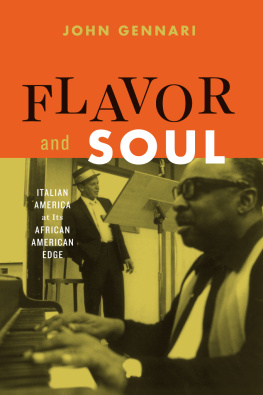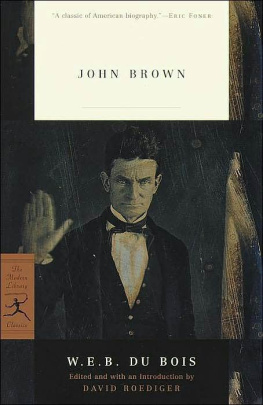Brown John - Patriotic treason: John Brown and the soul of America
Here you can read online Brown John - Patriotic treason: John Brown and the soul of America full text of the book (entire story) in english for free. Download pdf and epub, get meaning, cover and reviews about this ebook. City: New York, USA., year: 2006, publisher: Free Press, genre: Detective and thriller. Description of the work, (preface) as well as reviews are available. Best literature library LitArk.com created for fans of good reading and offers a wide selection of genres:
Romance novel
Science fiction
Adventure
Detective
Science
History
Home and family
Prose
Art
Politics
Computer
Non-fiction
Religion
Business
Children
Humor
Choose a favorite category and find really read worthwhile books. Enjoy immersion in the world of imagination, feel the emotions of the characters or learn something new for yourself, make an fascinating discovery.
- Book:Patriotic treason: John Brown and the soul of America
- Author:
- Publisher:Free Press
- Genre:
- Year:2006
- City:New York, USA.
- Rating:4 / 5
- Favourites:Add to favourites
- Your mark:
- 80
- 1
- 2
- 3
- 4
- 5
Patriotic treason: John Brown and the soul of America: summary, description and annotation
We offer to read an annotation, description, summary or preface (depends on what the author of the book "Patriotic treason: John Brown and the soul of America" wrote himself). If you haven't found the necessary information about the book — write in the comments, we will try to find it.
Brown John: author's other books
Who wrote Patriotic treason: John Brown and the soul of America? Find out the surname, the name of the author of the book and a list of all author's works by series.
Patriotic treason: John Brown and the soul of America — read online for free the complete book (whole text) full work
Below is the text of the book, divided by pages. System saving the place of the last page read, allows you to conveniently read the book "Patriotic treason: John Brown and the soul of America" online for free, without having to search again every time where you left off. Put a bookmark, and you can go to the page where you finished reading at any time.
Font size:
Interval:
Bookmark:

The Rhetoric of American Romance: Dialectic and Identity in
Emerson, Dickinson, Poe, and Hawthorne
The Marble Faun: Hawthornes Transformations
Situating College English: Lessons From an American State University
Writing Austins Lives: A Community Portrait
For Jacqueline and Rebecca,
women of courage and conscience

FREE PRESS
A Division of Simon & Schuster, Inc.
1230 Avenue of the Americas
New York, NY 10020
Copyright 2006 by Evan Carton
All rights reserved,
including the right of reproduction
in whole or in part in any form.
FREE PRESS and colophon are registered trademarks of Simon & Schuster, Inc.
Designed by Davina Mock
Library of Congress Cataloging-in-Publication Data is available
ISBN-13: 978-0-7432-9385-3
ISBN-10: 0-7432-9385-1
Visit us on the World Wide Web:
http://www.SimonSays.com
F OR DRAMA, CONTROVERSY, and historical impact, the life of John Brown exceeds that of any other private citizen of the United States. If American patriotism is defined as unqualified commitment to the nations founding religious and political idealsa commitment both to live by them and to die for themthen Brown may count as one of Americas first patriots, though he was not born until 1800 and was hanged for treason in 1859. Many nineteenth-century Americans, white and black, revered him; many others despised him. In the twentieth century, however, most academic historians sought to diminish Browns importance, reducing him to a caricature or a footnote in the civic imaginations of ordinary Americans.
John Brown is the stone in the historians shoe, novelist and essayist Truman Nelson wrote in The Nation in 1957, a century after Brown set in motion his campaign to free four million slavesa campaign that, from a military standpoint, began and ended with his raid on the U.S. arsenal at Harpers Ferry at the head of an interracial army of twenty-one men and boys. They cannot ignore him, but they try to choke him off in defaming parentheses. Nelsons image of the historians Brown as a stoneuncomfortable, immovable, unassimilatedechoes Browns portrayal in Stephen Vincent Bents 1928 Pulitzer-Prize-winning poem, John Browns Body, and anticipates Browns 1979 representation by biographer Stephen Oates. He was a stone. / A stone eroded to a cutting edge, Bent writes of his title character. He was Gods stone in the pool of slavery, Oates echoes.
John Brown was not a stone but a man of deep, varied, and sometimes conflicting capacities: for reason and faith, practicality and idealism, harshness and tenderness, isolation and intimacy, blindness, vision, transformation. He was a man, most significantly, who understood race, religion, and revolutionas these tangled legacies of Americas early history had come down to his generationto be the shaping conditions of his life and the nations life: and to confer inescapable demands on both. In my epilogue, The Unfinished American Revolution, I offer some reasons why Civil War historians have so often been hobbled by Brown and have scaled down the irritant to pebble-size dimensions by labeling him a fanatic or a failure. The aim of this book, however, is not to give reasons but to tell the timely true story of Browns life, his extraordinary family and friendships, and his country.
Since the 1970s, Browns portrait has been better painted and his place in American history reassessed in several valuable biographies and one fine novel, Russell Bankss Cloudsplitter. But historical novels select episodes and invent or alter characters and circumstances to achieve their creative designs, while scholarly convention limits the ability of biographers to dramatize the thoughts and feelings, the lived experience, of historical actors. Accordingly, even in such detailed and admiring nonfiction accounts as David Reynoldss recent John Brown, Abolitionist, which appeared as I was completing this manuscript, Brown remains somewhat abstract and alienan icon rather than a pebble, but still a stone.

This book is a work of nonfiction. Every scene, circumstance, action, and person I represent here is drawn in accordance with the available historical record. But there are crucial moments and passages in the historical story of John Brown to which the available record provides only a map, not a key. To enter into these moments and passages, to understand them more intimately, and to convey their living drama, I sometimes visualize the undescribed sensory and emotional particulars and imagine the unpreserved words, thoughts, and motives that animated them. In these instances, I derive the voices, ideas, and feelings of the historical actors as closely as possible from surviving letters and from contemporary third-person accounts of their character and style.

In July of 1846, the writer and naturalist Henry David Thoreau was arrested and jailed in Concord, Massachusetts, for refusing to pay his $1.50 poll tax. Thoreau committed his act of civil disobedience to protest his countrys first foreign imperialist campaign, the Mexican War, and its ever more extensive, brutal, and complacent use of black slave labor at home. Thoreau also meant his gesture to challenge the idea that government was a great impersonal machine the operations of which individual citizens could not affect and were not responsible for. Peaceful mass resistance by a citizenry that refused to accept its governments commission of unconscionable acts in its name could stop the machine and achieve a bloodless revolution, he argued in his greatest essay, Civil Disobedience. Yet: Even suppose blood should flow. Is there not a sort of blood shed when the conscience is wounded? Through this wound a mans real manhood and immortality flow out, and he bleeds to an everlasting death. I see this blood flowing now.
Fourteen years later, during a memorial service at John Browns gravesite on July 4, 1860, Thoreau returned to this theme of the life and death of conscience in recalling his first thought upon learning of Browns execution. Of all the men who were said to be my contemporaries, it seemed to me that John Brown was the only one who had not died. This book tells the story of John Brown, of where he lived and what he lived for, and of whythough his body moldershe lives on.
Was John Brown simply an episode, or was he an eternal truth?
W. E. B. DuBois
L IEUTENANT J. E. B. STUART of the First United States Cavalry crossed the yard of the Harpers Ferry armory and approached the thick oak door of the engine house under a flag of truce. He felt eyes on his back. In the gray first light of the raw morning of October 18, 1859, Stuart could make out the muzzles of two rifles protruding from gun holes that appeared to have been hastily chiseled through the engine house wall. He doubted that he had much to fear from the incompetent band of northerners and negroes trapped in the small building in front of him, fanatical haters of the southern system of labor that was protected by the countrys laws and enshrined in its traditions. He was at greater risk, he thought wryly, from the unsteady hands and judgment of his fellow Virginians who perched on the railroad trestle and the water tower and in every window of the hotel to his rear.
Drawn by the chilling news that white men in league with blacks had overrun the armory at Harpers Ferry and taken possession of its hundred thousand rifles and muskets, local militia companies and curious citizens from across the region had rushed to the snug commercial town throughout the preceding day and night. Harpers Ferry, Virginia, nestled at the tip of the peninsula bounded by the converging Shenandoah and Potomac rivers. Their churning waters formed a gateway to the Shenandoah Valley, which unfolded to the south. From its main street, lined with shops and government offices, the town ascended into the lush foothills of the Blue Ridge, finally reaching the Bolivar Heights plateau. Tidy and scenic as a Swiss mountain village, Harpers Ferry seemed an idyll of quiet and peace, but it was notat least, not this morning. Stuart estimated that two thousand citizensfrenzied, sleepless, intoxicated, and armedthronged doorways, windows, and rooftops and lined both riverbanks, surrounding the armory complex. The wall and the high arched doors of the engine house were already pocked and splintered by their buckshot and pistol balls. It was not the watery sun struggling to crest the soaring Maryland Heights that warmed his cheek and neck as he advanced but those grim stares, hot with outrage, heavy with fear.
Font size:
Interval:
Bookmark:
Similar books «Patriotic treason: John Brown and the soul of America»
Look at similar books to Patriotic treason: John Brown and the soul of America. We have selected literature similar in name and meaning in the hope of providing readers with more options to find new, interesting, not yet read works.
Discussion, reviews of the book Patriotic treason: John Brown and the soul of America and just readers' own opinions. Leave your comments, write what you think about the work, its meaning or the main characters. Specify what exactly you liked and what you didn't like, and why you think so.










